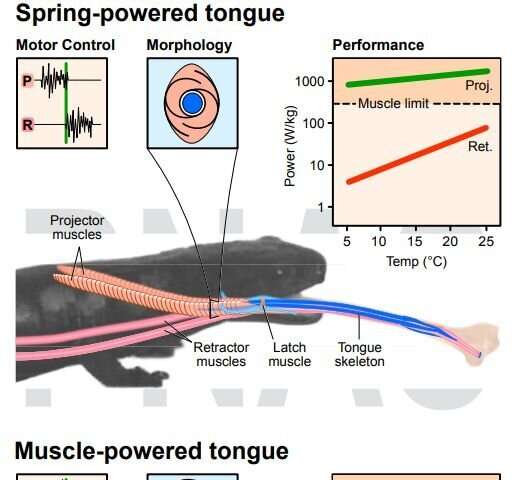Summary of the major differences in tongue-projection mechanisms in plethodontid salamanders. The ballistic, spring-powered, high performance and thermally robust tongue (Upper), represented here by Bolitoglossa, shows a motor control pattern with early activation of the projector muscle (P) relative to tongue launch (vertical green line), a projector muscle (peach in anatomical drawing and in muscle cross-section) with spiral aponeuroses that act as springs surrounding but not attaching to a round skeletal element (dark blue) that can be launched completely from the muscle and the mouth. Peak projection power of this tongue type (green line in graph) is much higher, exceeding the muscle limit of ∼400 W/kg, and more thermally robust than muscle-powered tongue retraction (red line). The muscle-powered, thermally sensitive tongue (Lower), represented by Desmognathus, shows a motor control pattern with nearly simultaneous activation of projector and retractor muscles (pink) nearer to tongue launch, projector muscle without spiral aponeuroses and with inner myofibers (orange) inserting onto the elliptical tongue skeletal element, which cannot be launched entirely from the mouth. The tongue pad is attached to the lower jaw by a stout genioglossus muscle. Projection and retraction show similar, modest performance and high thermal sensitivity. Credit: Proceedings of the National Academy of Sciences (2020). DOI: 10.1073/pnas.1921807117
A team of researchers from the University of South Florida and California State University Stanislaus has found that just a few minor evolutionary changes led to the development of the superfast salamander tongue. In their paper published in Proceedings of the National Academy of Sciences, the group describes their study of a variety of salamander species and what they learned about their strong elastic recoil mechanism.
Salamanders have notoriously fast tongues—they shoot them out of their mouths at high velocity to capture swiftly reacting prey such as flies. In this new effort, the researchers undertook a study of the salamander and its tongue to learn more about how it functions and how it developed.
The work focused most specifically on lungless salamanders—species that breathe through their skin and oral mucus membranes. They took high-speed video of 162 specimens from dozens of species during 1,952 feeding events. Study of the video revealed the mechanism involved when the tongue is in action. They found that rather than ejecting the tongue using muscular force, the salamanders used a spring-loaded mechanism to shoot their tongue out of their mouth like an arrow from a bow.
In comparing species that continue to use muscle force to expel their tongues with those that use the spring-loaded approach, the researchers found very minor physical differences. They suggest this indicates that small evolutionary changes were necessary to develop the spring-loaded mechanism that significantly increased the speed at which the tongue was expelled. They also found examples of physical differences between species that suggest they developed the spring-loaded approach independently.
The researchers were also curious about whether the speed of tongue ejection might be impacted by environmental temperatures because salamanders are cold-blooded. To find out if that might be the case, some of the specimens were filmed while under different temperatures. The researchers found that temperature differences did not impact the speed of the tongue ejections—but it did for tongue retractions. The colder it was, the more time it took for the salamander to retrieve its tongue.
More information: Stephen M. Deban et al. Evolution of a high-performance and functionally robust musculoskeletal system in salamanders, Proceedings of the National Academy of Sciences (2020). DOI: 10.1073/pnas.1921807117
Journal information: Proceedings of the National Academy of Sciences
© 2020 Science X Network
























